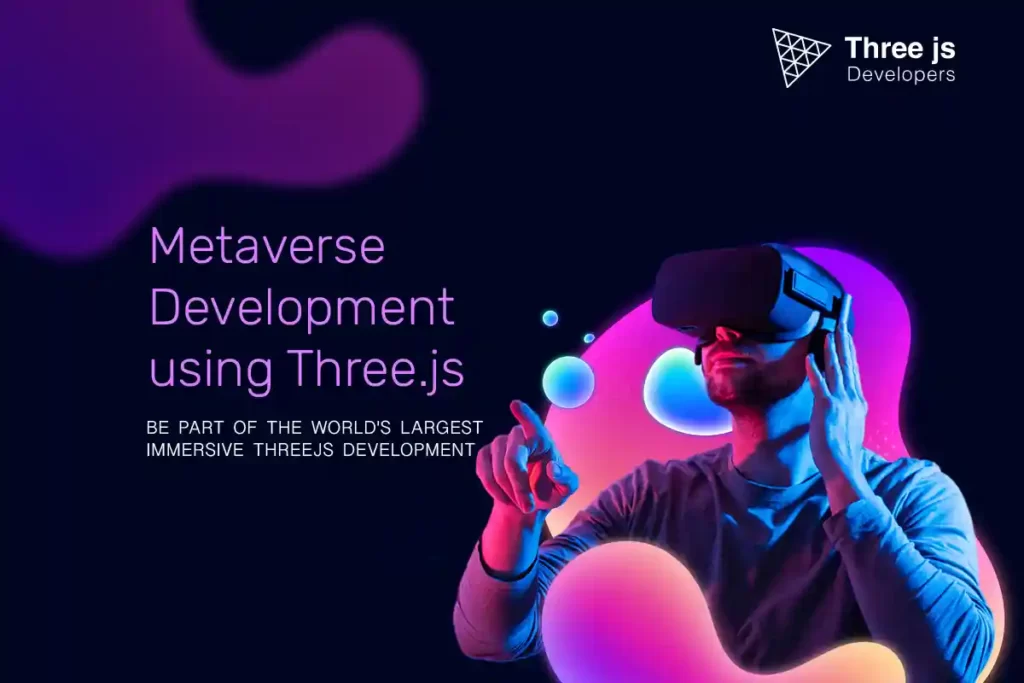Metaverse, the future of a connected world where digital realities fluidly interact with each other, is already here, and in the history of Metaverse, Three.js, as the most versatile and well-equipped 3D development library, will be there.
The library that developers like for their 3D graphics and animation projects can be a stepping stone for your ambitious Metaverse project.
In this simple guide, we’ll talk about Three.js, a tool that can help us make 3D apps for the Metaverse.
Let’s introduce Three.js
Three.js is written in Javascript and holds a unique position among all JavaScript libraries for its 3D and animation-building capabilities.
It takes the earlier WebGL features to a more advanced level and brings a lot of immersive elements into the mix. The best thing about the framework is that by using it, you can create detailed and multitude-layered visuals and eye-catching animated effects with a little effort and time.
Another important reason it became so popular is the ease of use and low code footprint. By using this framework, 3D web developers can shape highly versatile and dynamic 3D environments while writing only byte-sized code.
When you want to achieve an engaging 3D experience for your web app without investing a lot of resources, Three.js fits the bill.
Why use Three.js for Metaverse Development?
Regarding Metaverse development, you have plenty of advantages with Three.js. First, it provides many resources for shaping complex ideas into dynamic 3D scenes.
This makes your ambitious Metaverse projects much easier. By using the framework, web developers can use almost every kind of 3D graphic design and rendering tool out of the box.
Three.js offers tools for every type of lighting effect, a variety of textures, as well as robust features for motion graphics and animation.
Capabilities On the other hand, in a versatile and no-bounds platform like Metaverse, you must ensure ultimate scalability; the framework is the best 3D development choice.
Cross-platform compatibility only adds to the versatility of the framework. Lastly, building its 3D development capabilities from WebGL and WebVR makes the user experience more immersive. For Metaverse, when you develop technologies to be “no-holds-barred” in nature, Three.us brings the ideal choice.
How to Get Started Metaverse Development with Three.js?
Do you want to start using Three.js for your next Metaverse project? Before embarking on the framework, it is always advisable to have a solid understanding of 3D development, 3D rendering on the web, and how various web standards and the 3D web have evolved over the years.
From fixing the axes of orientation to camera navigation to scene organization and many others, there are many things directly related to technical proficiency.
First, Let’s explain the orientation of axes from a graphic designer’s perspective. Technically speaking, it works for setting the right coordinates to shape the graphics and objects in a visually balanced way.
On the other hand, camera navigation in a 3D environment can help you experiment a lot with displaying scenes from different angles.
If more is needed, the objects in a Three.js powered app come with various materials and object-specific textures. Using many visual attributes and characteristics, you can give your intended app a more engaging look and feel.
Examples of Metaverse Development Using Three.js:
As we have explained above, for Metaverse development, Three.js brings just the right mix of capabilities, and it also promises to scale up 3D capabilities while always ensuring optimum scalability and breathable performance.
Whether building an interactive online store or a digital training environment involving immersive 3D graphics, Three.js brings you the best, irrespective of the niche.
The framework allows unlimited customization scope to suit your 3D graphics and animation creation capabilities.
Do you want to create web-based augmented or virtual reality experiences for any niche? The framework allows you to use AR and VR fully, often writing a few lines of code.
The power of Three.js is best experienced by developers and businesses when they align the capabilities of this excellent framework with the graphic storytelling capabilities of other technologies.
Three.js is versatile enough to accommodate many third-party tools, frameworks, and libraries.
The ease of using Three.js and its surprisingly lower learning curve are key factors behind its popularity.
This is why both seasoned and expert developers and the would-be developers of today can start with this framework and develop practically anything and everything compatible with the 3D web.
Do you want some ideas about Metaverse development, where many digital worlds join hands and collaborate? Three.js fits into this connected digital reality involving simulations, multilayered visualizations, and immersive interactions.
For your web project, you want something lightweight, easy, and simple to shape the 3D web experience and one that can help you build your stakes.
Metaverse? Let’s not have any second thoughts about the Three.js capabilities that make it ideal for similar projects.
Conclusion:
As an overall summary of what we have explained, Three.js will lead the 3D development scene simply because it is irreplaceable for all the features and capabilities you need.
The connected and immersive ecosystem of technologies is fast evolving, and the emergence of Metaverse has become a watershed moment for the fluid interactions of multiple digital realities. This is where the promise of Three.us holds.
Ready to dive into the Metaverse madness? Our Three.js developers is on it! They’re wizards at crafting 3D visuals and wild virtual escapades. So, team up with us, and let’s cook up some digital magic that’ll have folks talking.



